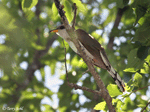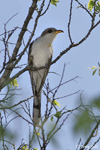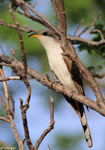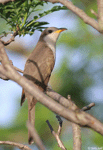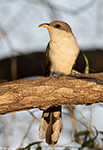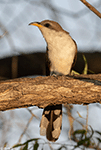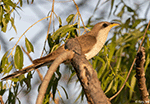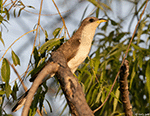Yellow-billed Cuckoo
Coccyzus americanus
| Length: 11 to 13 inches | Wingspan: 15 to 17 inches | Seasonality: Summer |
| ID Keys: Grayish-brown above, white below, decurved bill with dark upper and yellow lower mandible, tail black underneath with large white spots. | ||
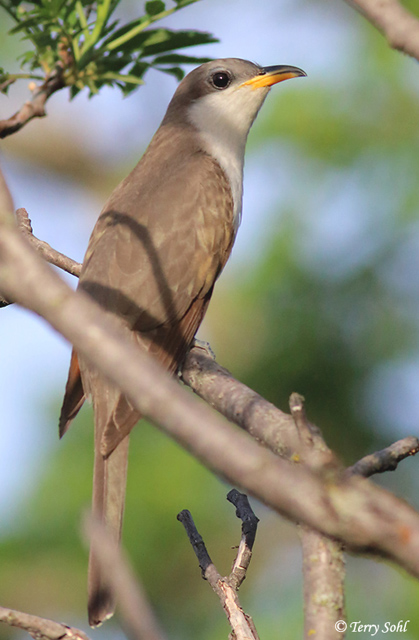 The Yellow-billed Cuckoo
is probably heard more than seen, as their loud croaking calls emanating from
dense forest can often be heard for long distances. They are locally known as
the "rain crow" in parts of the U.S., as it is said their loud calls
are predictions of rain. Yellow-billed Cuckoos are sometimes practice nest
parasitism, but primarily only do so in the nests of Black-billed
Cuckoos. They have also been known to lay eggs in the nests of
American Robins,
Gray Catbirds,
Eastern Towhee, and
Wood Thrush.
The Yellow-billed Cuckoo
is probably heard more than seen, as their loud croaking calls emanating from
dense forest can often be heard for long distances. They are locally known as
the "rain crow" in parts of the U.S., as it is said their loud calls
are predictions of rain. Yellow-billed Cuckoos are sometimes practice nest
parasitism, but primarily only do so in the nests of Black-billed
Cuckoos. They have also been known to lay eggs in the nests of
American Robins,
Gray Catbirds,
Eastern Towhee, and
Wood Thrush.
Habitat:
Primarily breeds in dense deciduous forests, often with a water source nearby.
Diet:
Yellow-billed Cuckoo populations often depend heavily on caterpillars. Tent caterpillars are a favorite, with individual birds sometimes consuming dozens of the small caterpillars at one meal. They also will feed on beetles, grasshoppers, cicadas, bird eggs, small lizards, frogs, and fruits and berries.
Behavior:
Primarily forages by climbing and flitting through the foliage, gleaning insects from leaves and branches as it goes. They will also on occasion fly out from a perch to capture passing insects in mid-air. Most foraging is done slowly and deliberately.
Nesting:
May through June in South Dakota. The nest is a shallow elongated cup, built by both the male and the female. 2 to 5 eggs are laid, with both parents sharing incubation duties, although the male alone incubates the eggs at night. The eggs hatch after 10 or 11 days, and the young grow incredibly fast. The entire nesting period of a Yellow-billed Cuckoos can be as short as 17 days after the eggs are first laid, with young fledging the nest only a week after they first hatch. .
Song:
One of the most commonly heard vocalizations is a series of slow, cooing awk-awk-awk-awk calls. The males also have a descending cak-cak-cak-caak-caak-caaaak that slows down as the call progresses.
1Click here to hear the cooing awk-awk-awk-awk calls of a Yellow-billed Cuckoo.
2Click here to hear the descending calls of a Yellow-billed Cuckoo.
Migration:
Summers throughout the eastern half of the U.S., and locally in the southwest and western U.S. A long-distance migrant, wintering in Central and South America.
Interactive eBird map:
Click here to access an interactive eBird map of Yellow-billed Cuckoo sightings
Similar Species:
Rather distinctive if seen well, with a long tail and bill shape that even irrespective of plumage makes them stand out in a crowd. However, they could be confused with other Cuckoo species (only one of which is found in South Dakota).
- Black-billed Cuckoo overlap in range and habitat with Yellow-billed Cuckoos, and share the same general size and structure. However, Black-billed Cuckoos have (obviously!) a black bill compared to the yellow bill of a Yellow-billed Cuckoo. The underside of the ail on a Black-billed Cuckoo is grayish overall with distinctive white tips, while the underside of the tail on a Yellow-billed Cuckoo is black with bold white spots. The eye of a Black-billed Cuckoo typically has a reddish ring around it that's lacking on a Yellow-billed Cuckoo. Finally, the upperside plumage on a Black-billed Cuckoo tends to be a "cooler", grayer shade of brown, while that of a Yellow-billed Cuckoo is more of a warm brown.
- Mangrove Cuckoo is a species found in Florida and the Caribbean, but in range could be confused with a Yellow-billed Cuckoo. In some ways the Mangrove Cuckoo looks like a cross between a Black-billed and a Yellow-billed Cuckoo. The underside of the tail is blackish with large white spots, like a Yellow-billed Cuckoo, and the bill on both species is yellow on the lower mandible. The upperside plumage of a Mangrove Cuckoo, however, is a cooler color of brown, like a Black-billed Cuckoo. The easiest way to identify a Mangrove Cuckoo however is the peachy warm tones found on its underside, compared to the white underside of a Yellow-billed Cuckoo.
Status:
Numbers have shown a general decline in recent decades, particularly in the western part of its range (due to habitat loss). There also tend to be fairly large annual changes in local populations as insect populations rise and fall. However, Yellow-billed Cuckoos are still found across a broad geographic area and are relatively common in parts of that range. The IUCN considers the Yellow-billed Cuckoo to be a species of "Least Concern".
South Dakota "Hotspot"
Yellow-billed Cuckoos can be tough to find in South Dakota, given their habitat preference. However, Newton Hills State Park holds decent numbers of Cuckoos in the summer months. Spotting one by sight may be difficult, but they can sometimes be heard calling, particularly in the spring.
Further Information:
1) BirdWeb - Yellow-billed Cuckoo
2) WhatBird - Yellow-billed Cuckoo
3) Audubon Field Guide - Yellow-billed Cuckoo
Photo Information:
May 27th, 2018 - Newton Hills State Park, South Dakota - Terry Sohl
Additional Photos:
Click on the image chips or text links below for additional, higher-resolution Yellow-billed Cuckoo photos.
Audio File Credits:
1Richard E. Webster. Recorded in Alamos, Sonara, Mexico on July 23rd, 2019. Original recording and information from xeno-canto.
2Mike Nelson. Recorded in Cross Mountain, Tennessee on April 29th, 2012. Original recording and information from xeno-canto.
| Click on the map below for a higher-resolution view |
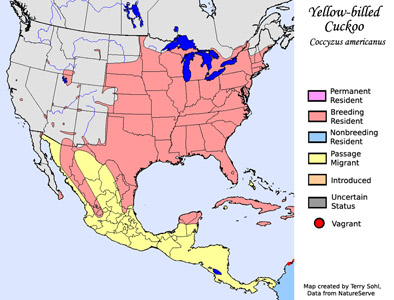 |
| South Dakota Status: Uncommon summer breeding resident in the southeastern part of the state, less common elsewhere in the state. |
Additional Yellow-billed Cuckoo Photos
Click for a higher-resolution version of these photos
